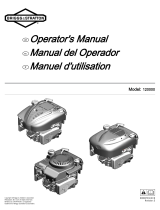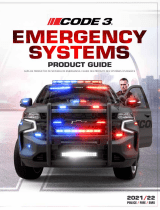
ver en www.BRIGGSandSTRATTON.COM. Los valores de potencia neta se obtienen
con un limpiador de aire y un escape instalados, mientras que los valores de potencia
bruta se recopilan sin estos aditamentos. La potencia bruta real del motor es mayor
que la potencia neta del motor y depende, entre otros factores, de las condiciones
ambientales de uso y de las variaciones entre los motores. Dada la amplia gama de
productos donde se colocan los motores, el motor de gasolina puede no desarrollar
la potencia bruta nominal cuando se usa en un equipo de potencia determinado. Esta
diferencia se debe, entre otros, a los siguientes factores: variedad de componentes
del motor (limpiador de aire, escape, carga, enfriamiento, carburador, bomba de
combustible, etc.), limitaciones de la aplicación, condiciones ambientales de uso
(temperatura, humedad, altitud) y variaciones entre los motores. Debido a limitaciones
de fabricación y capacidad, Briggs&Stratton puede sustituir un motor de una potencia
nominal mayor por este motor.
Garantía
Garantía para motores Briggs&Stratton
Vigente a partir de enero de 2019
Garantía limitada
Briggs&Stratton garantiza que, durante el período de garantía especificado a
continuación, reparará o reemplazará, sin cargo, cualquier pieza defectuosa en cuanto
a material, mano de obra o ambos. Los gastos de transporte del producto sometido a
reparación o cambio conforme a garantía deben ser abonados por el comprador. Esta
garantía se mantiene vigente durante los períodos de tiempo indicados a continuación
y está sujeta a dichos períodos y a las condiciones presentadas a continuación. Para
servicio de garantía, localice al distribuidor de servicio autorizado más cercano en
nuestro mapa de localizador de distribuidores en BRIGGSandSTRATTON.COM.
El comprador debe ponerse en contacto con el distribuidor de servicio autorizado y
entregarle el producto para la inspección y prueba.
No existe ninguna otra garantía explícita. Las garantías implícitas, incluidas las de
comerciabilidad y aptitud para una finalidad específica, están limitadas al período
de garantía mencionado a continuación, o en la medida en que lo permita la ley.
La responsabilidad de daños fortuitos o consecuentes queda excluida en la medida
que dicha exclusión esté permitida por ley. Algunos estados o países no contemplan
limitaciones en cuanto a la duración de una garantía implícita, y otros estados o países
no permiten la exclusión o limitación de daños consecuentes o incidentales, en cuyo
caso es posible que la limitación y la exclusión anteriores no sean aplicables para
usted. Esta garantía le da derechos legales específicos, pudiendo tener a su vez otros
derechos que varían de un estado a otro o de un país a otro
4
.
Términos de la garantía estándar
1, 2, 3
Vanguard®; Serie comercial
3
Uso privado: 36meses
Uso comercial: 36meses
SerieXR
Uso privado: 24meses
Uso comercial: 24meses
Todos los demás motores con manga de hierro fundido Dura-Bore™
Uso privado: 24meses
Uso comercial: 12meses
Todos los demás motores
Uso privado: 24meses
Uso comercial: 3meses
1
Estos son nuestros términos estándar de garantía, pero ocasionalmente puede
haber una cobertura de garantía adicional no determinada en el momento de la
publicación. Para obtener una lista de los términos actuales de garantía para su
motor, vaya a BRIGGSandSTRATTON.com o contáctese con el distribuidor de
servicio autorizado de Briggs&Stratton.
2
No hay garantía para los motores de los equipos usados para suministrar
energía primaria en sustitución de un servicio público, los generadores de energía
de emergencia para fines comerciales, los vehículos utilitarios que excedan una
velocidad máxima de 25mph, o los motores que se usan en eventos competitivos
o en pistas de carreras comerciales o de alquiler.
3
Vanguard instalado en generadores de energía de emergencia: 24meses
para uso privado y sin garantía para uso comercial. Serie comercial con fecha de
fabricación previa a juliode2017: 24meses para uso privado, 24meses para uso
comercial.
4
En Australia: nuestros productos vienen con garantías que no se pueden
excluir bajo la Ley australiana de protección al consumidor. Usted tiene derecho
a una sustitución o a un reembolso por una avería importante y a compensación
por cualquier otra pérdida o daño razonablemente previsibles. También tiene
derecho a la reparación o el reemplazo de los productos si estos no son de
una calidad aceptable y la falla no equivale a una gran falla. Para obtener el
servicio de garantía, busque al distribuidor de servicio autorizado más cercano
en el mapa localizador de distribuidores en BRIGGSandSTRATTON.COM
o llamando al 1300274447, o mediante un correo electrónico o carta a
Moorebank Avenue, Moorebank, NSW, Australia, 2170.
El período de garantía comienza en la fecha original de compra por parte del primer
consumidor minorista o comercial. “Uso privado” significa uso doméstico personal por
parte de un consumidor final. “Uso comercial” significa todos los demás usos, incluidos
los usos con fines comerciales, de generación de ingresos o alquiler. Una vez que el
motor haya experimentado uso comercial, será considerado en adelante como motor de
uso comercial a los fines de esta garantía.
Guarde su recibo de comprobante de compra. Si no aporta un comprobante de la
fecha de compra inicial al solicitar el servicio de garantía, se tomará la fecha de
fabricación del producto para determinar el periodo de garantía. No se requiere
el registro del producto para obtener el servicio de garantía en los productos de
Briggs&Stratton.
Acerca de su garantía
Esta garantía limitada cubre únicamente problemas de materiales y/o mano de obra
asociados al motor, y no la sustitución o el reembolso del equipo en el que el motor
puede estar montado. El mantenimiento de rutina, la puesta a punto, los ajustes o el
desgaste normal no están cubiertos bajo esta garantía. Asimismo, la garantía queda
anulada si el motor ha sido alterado o modificado, o si el número de serie del motor ha
sido desfigurado o eliminado. Esta garantía no cubre daños al motor o problemas de
desempeño causados por:
1. El uso de piezas que no son piezas originales Briggs&Stratton;
2. El funcionamiento del motor con aceite lubricante insuficiente, contaminado o de
grado incorrecto;
3. El uso de combustible contaminado o rancio, gasolina formulada con un contenido
de etanol mayor al 10%, o el uso de combustibles alternativos tales como
gas licuado del petróleo o gas natural en motores no diseñados o fabricados
originalmente por Briggs & Stratton para operar con tales combustibles;
4. Suciedad que ingresa al motor debido a mantenimiento o reensamblaje incorrecto
del limpiador de aire;
5. Golpear un objeto con la cuchilla de corte de un cortacésped rotatorio, adaptadores
de la cuchilla, impulsores u otros dispositivos acoplados al cigüeñal sueltos o
instalados incorrectamente, o excesiva tirantez de la correa en V;
6. Piezas o ensambles asociados, tales como embragues, transmisiones, controles de
equipos, etc., no suministrados por Briggs & Stratton;
7. Sobrecalentamiento debido a recortes de hierba, suciedad y desechos, o nidos
de roedores que taponan u obstruyen las aletas de refrigeración o el área de la
volante, o por poner en funcionamiento el motor sin suficiente ventilación;
8. Vibración excesiva debida al exceso de velocidad, montaje flojo del motor,
cuchillas o impulsores flojos o no balanceados, o acoplamiento incorrecto de los
componentes del equipo al cigüeñal;
9. Uso incorrecto, falta de mantenimiento de rutina, transporte, manipulación o
almacenamiento de los equipos, o instalación incorrecta del motor.
El servicio de garantía solo está disponible a través de los distribuidores de
servicio autorizados de Briggs&Stratton. Ubique a su distribuidor de servicio
autorizado más cercano en nuestro mapa localizador de distribuidores en el sitio
BRIGGSandSTRATTON.COM o llamando al 1-800-233-3723 (en EE.UU.).
80004537 (Rev.F)
Garantía de emisiones de Briggs & Stratton
Garantía sobre control de emisiones de California, EPA de EE.UU. y
Briggs&Stratton, LLC - Sus derechos y obligaciones bajo la garantía
Para Modelos de Motor Briggs&Stratton con designación de versión “B” o
“G” (Modelo-Tipo-Representación de Reglaje xxxxxx xxxx Bx o xxxxxx xxxx Gx)
La Junta de Recursos del Aire de California, la EPA de EE.UU. y Briggs&Stratton
(B&S) se complacen en explicar la garantía del sistema de control de emisiones
de escape (“emisiones”) de su motor modelo2020-2022. En California, los nuevos
motores pequeños todo terreno y los motores grandes con ignición por bujías no
superiores a 1,0litro deben estar diseñados, fabricados y equipados conforme a
los exigentes estándares estatales de lucha contra la contaminación. B&S debe
garantizar el sistema de control de emisiones de su motor durante los períodos
que se indican a continuación, siempre que no haya habido maltrato, negligencia o
mantenimiento indebido de su motor pequeño todo terreno o equipo que da como
resultado la falla del sistema de control de emisiones.
Su sistema de control de emisiones puede incluir piezas como el carburador o el
sistema de inyección de combustible, el sistema de ignición, el conversor catalítico, los
tanques de combustible, las líneas de combustible (para combustible líquido y vapores
de combustible), tapas de combustible, válvulas, cámaras, filtros, abrazaderas y otros
componentes asociados. También puede incluir mangueras, correas, conectores y
otros conjuntos relacionados con el sistema de control de emisiones.
Cuando exista una condición sujeta a garantía, B&S reparará su motor sin costo
alguno para usted, lo que incluye diagnóstico, piezas y mano de obra.
Cobertura de la garantía del fabricante:
20 vanguardpower.com
























